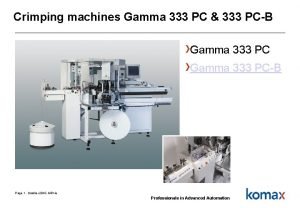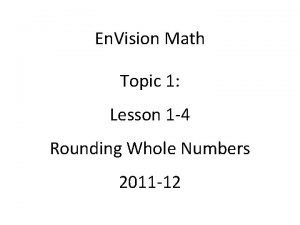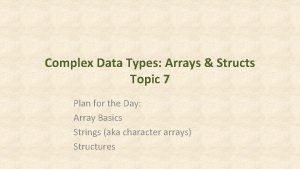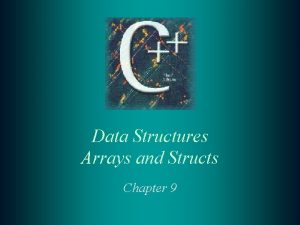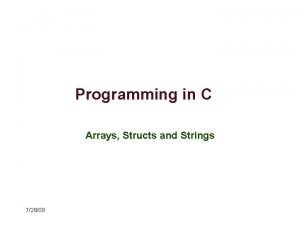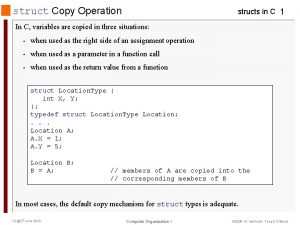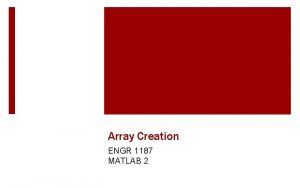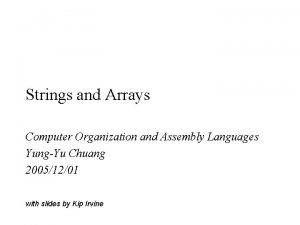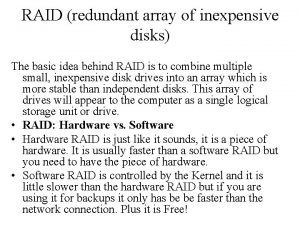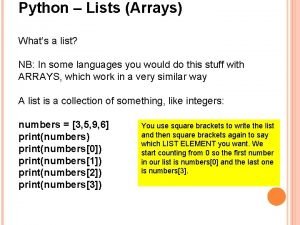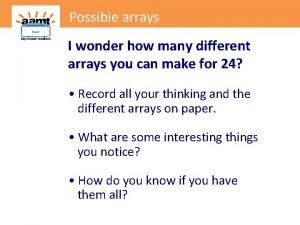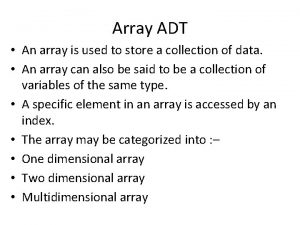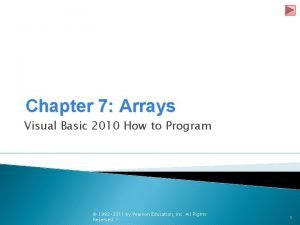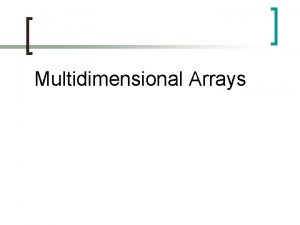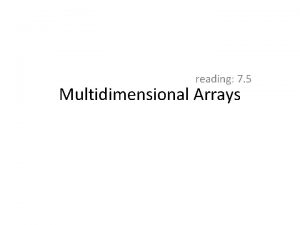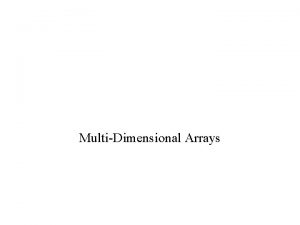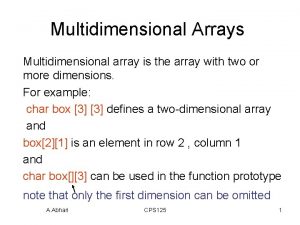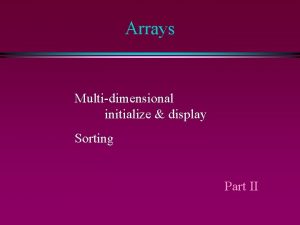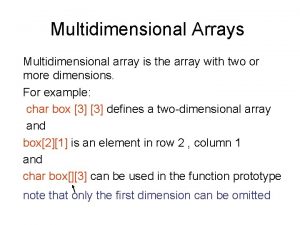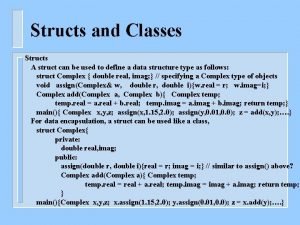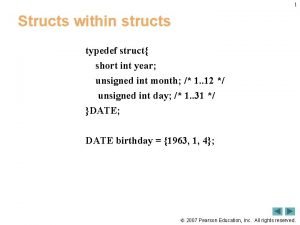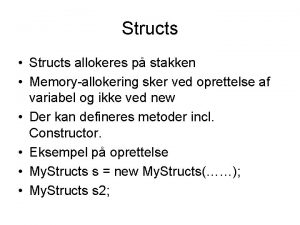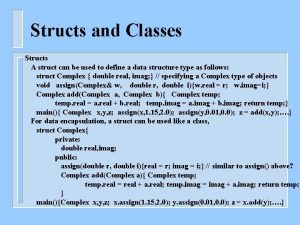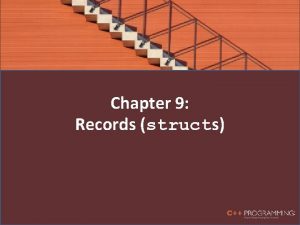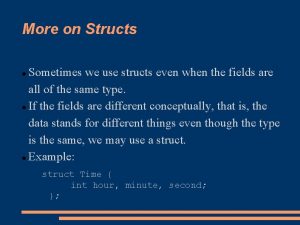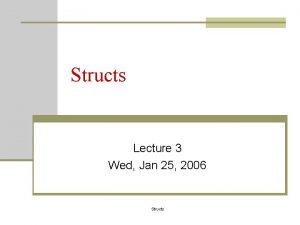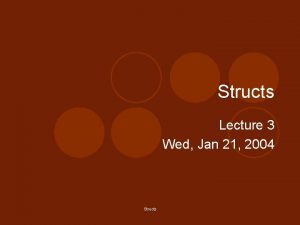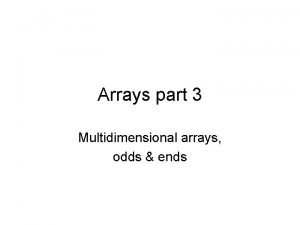Structs Multidimensional arrays Alignment CS 295 Structs Alignment


![Structs, Multi-dimensional arrays & Alignment CS 295 Array Allocation v char msg[12]; x x Structs, Multi-dimensional arrays & Alignment CS 295 Array Allocation v char msg[12]; x x](https://slidetodoc.com/presentation_image_h2/cbe4e482e476dfbd6fc083c73a1d6a47/image-3.jpg)
![Structs, Multi-dimensional arrays & Alignment CS 295 Array Access v 3 int x[5]; a Structs, Multi-dimensional arrays & Alignment CS 295 Array Access v 3 int x[5]; a](https://slidetodoc.com/presentation_image_h2/cbe4e482e476dfbd6fc083c73a1d6a47/image-4.jpg)
![Structs, Multi-dimensional arrays & Alignment CS 295 Array Example typedef int zip_dig[5]; zip_dig cmu Structs, Multi-dimensional arrays & Alignment CS 295 Array Example typedef int zip_dig[5]; zip_dig cmu](https://slidetodoc.com/presentation_image_h2/cbe4e482e476dfbd6fc083c73a1d6a47/image-5.jpg)


![Structs, Multi-dimensional arrays & Alignment typedef int zip_dig[5]; Referencing Examples 1 zip_dig cmu; 16 Structs, Multi-dimensional arrays & Alignment typedef int zip_dig[5]; Referencing Examples 1 zip_dig cmu; 16](https://slidetodoc.com/presentation_image_h2/cbe4e482e476dfbd6fc083c73a1d6a47/image-8.jpg)
![Structs, Multi-dimensional arrays & Alignment Nested Array Example zip_dig {{ 9, sea[4] = 8, Structs, Multi-dimensional arrays & Alignment Nested Array Example zip_dig {{ 9, sea[4] = 8,](https://slidetodoc.com/presentation_image_h2/cbe4e482e476dfbd6fc083c73a1d6a47/image-9.jpg)
![Structs, Multi-dimensional arrays & Alignment typedef int zip_dig[5]; Nested Array Example zip_dig {{ 9, Structs, Multi-dimensional arrays & Alignment typedef int zip_dig[5]; Nested Array Example zip_dig {{ 9,](https://slidetodoc.com/presentation_image_h2/cbe4e482e476dfbd6fc083c73a1d6a47/image-10.jpg)
![Structs, Multi-dimensional arrays & Alignment CS 295 Two-Dimensional (Nested) Arrays v Declaration: T A[R][C]; Structs, Multi-dimensional arrays & Alignment CS 295 Two-Dimensional (Nested) Arrays v Declaration: T A[R][C];](https://slidetodoc.com/presentation_image_h2/cbe4e482e476dfbd6fc083c73a1d6a47/image-11.jpg)
![Structs, Multi-dimensional arrays & Alignment CS 295 Two-Dimensional (Nested) Arrays v Declaration: T A[R][C]; Structs, Multi-dimensional arrays & Alignment CS 295 Two-Dimensional (Nested) Arrays v Declaration: T A[R][C];](https://slidetodoc.com/presentation_image_h2/cbe4e482e476dfbd6fc083c73a1d6a47/image-12.jpg)







![Structs, Multi-dimensional arrays & Alignment CS 295 Structure Representation struct rec { int a[4]; Structs, Multi-dimensional arrays & Alignment CS 295 Structure Representation struct rec { int a[4];](https://slidetodoc.com/presentation_image_h2/cbe4e482e476dfbd6fc083c73a1d6a47/image-20.jpg)
![Structs, Multi-dimensional arrays & Alignment CS 295 Structure Representation struct rec { int a[4]; Structs, Multi-dimensional arrays & Alignment CS 295 Structure Representation struct rec { int a[4];](https://slidetodoc.com/presentation_image_h2/cbe4e482e476dfbd6fc083c73a1d6a47/image-21.jpg)








![Structs, Multi-dimensional arrays & Alignment CS 295 Structures & Alignment v c i[0] p Structs, Multi-dimensional arrays & Alignment CS 295 Structures & Alignment v c i[0] p](https://slidetodoc.com/presentation_image_h2/cbe4e482e476dfbd6fc083c73a1d6a47/image-30.jpg)








- Slides: 38

Structs, Multi-dimensional arrays & Alignment CS 295 Structs & Alignment Acknowledgments: These slides have been modified by Arrvindh Shriraman, Justi

Structs, Multi-dimensional arrays & Alignment CS 295 Data Structures in Assembly v v Arrays § One-dimensional § Multi-dimensional (nested) § Multi-level Structs § Alignment 2
![Structs Multidimensional arrays Alignment CS 295 Array Allocation v char msg12 x x Structs, Multi-dimensional arrays & Alignment CS 295 Array Allocation v char msg[12]; x x](https://slidetodoc.com/presentation_image_h2/cbe4e482e476dfbd6fc083c73a1d6a47/image-3.jpg)
Structs, Multi-dimensional arrays & Alignment CS 295 Array Allocation v char msg[12]; x x + 12 int val[5]; x x+4 x+8 x + 12 x + 16 x + 20 double a[3]; x x+8 x + 16 x + 24 char* p[3]; (or char *p[3]; ) x + 16 x + 24 3
![Structs Multidimensional arrays Alignment CS 295 Array Access v 3 int x5 a Structs, Multi-dimensional arrays & Alignment CS 295 Array Access v 3 int x[5]; a](https://slidetodoc.com/presentation_image_h2/cbe4e482e476dfbd6fc083c73a1d6a47/image-4.jpg)
Structs, Multi-dimensional arrays & Alignment CS 295 Array Access v 3 int x[5]; a 7 a+4 1 a+8 9 a+12 5 a+16 a+20 x[4] int 5 x int* a x+1 int* a + 4 &x[2] int* a + 8 x[5] int ? ? (whatever’s in memory at addr x+20) *(x+1) int 7 x+i int* a + 4*i 4
![Structs Multidimensional arrays Alignment CS 295 Array Example typedef int zipdig5 zipdig cmu Structs, Multi-dimensional arrays & Alignment CS 295 Array Example typedef int zip_dig[5]; zip_dig cmu](https://slidetodoc.com/presentation_image_h2/cbe4e482e476dfbd6fc083c73a1d6a47/image-5.jpg)
Structs, Multi-dimensional arrays & Alignment CS 295 Array Example typedef int zip_dig[5]; zip_dig cmu = { 1, 5, 2, 1, 3 }; zip_dig sfu = { 9, 8, 1, 9, 5 }; zip_dig ucb = { 9, 4, 7, 2, 0 }; v initialization typedef: Declaration “zip_dig sfu” equivalent to “int sfu[5]” 5

Structs, Multi-dimensional arrays & Alignment CS 295 C Details: Arrays and Pointers v Arrays are (almost) identical to pointers § char *string and char string[] are nearly identical declarations § Differ in subtle ways: initialization, sizeof(), etc. v v An array name looks like a pointer to the first (0 th) element § ar[0] same as *ar; ar[2] same as *(ar+2) An array name is read-only (no assignment) § Cannot use "ar = <anything>" 7

Structs, Multi-dimensional arrays & Alignment CS 295 C Details: Arrays and Functions v Declared arrays only allocated while the scope is valid: char* foo() { char string[32]; . . . ; return string; } v BAD! An array is passed to a function as a pointer: § Array size gets lost! int foo(int ar[], unsigned Really intint *ar size) {. . . ar[size-1]. . . } Must explicitly pass the size! 8
![Structs Multidimensional arrays Alignment typedef int zipdig5 Referencing Examples 1 zipdig cmu 16 Structs, Multi-dimensional arrays & Alignment typedef int zip_dig[5]; Referencing Examples 1 zip_dig cmu; 16](https://slidetodoc.com/presentation_image_h2/cbe4e482e476dfbd6fc083c73a1d6a47/image-8.jpg)
Structs, Multi-dimensional arrays & Alignment typedef int zip_dig[5]; Referencing Examples 1 zip_dig cmu; 16 20 9 zip_dig sfu; 36 v 24 40 56 1 4 Reference Address sfu[3] sfu[6] sfu[-1] cmu[15] 36 36 36 16 4* 3 4* 6 4*-1 4*15 48 60 32 76 3 32 9 48 7 64 = = 1 28 44 60 + + 2 8 9 zip_dig ucb; v 5 CS 295 36 5 52 2 68 56 0 72 76 Value Guaranteed? 9 4 3 ? ? Yes No No bounds checking Example arrays happened to be allocated in successive 20 byte blocks § Not guaranteed to happen in general 9
![Structs Multidimensional arrays Alignment Nested Array Example zipdig 9 sea4 8 Structs, Multi-dimensional arrays & Alignment Nested Array Example zip_dig {{ 9, sea[4] = 8,](https://slidetodoc.com/presentation_image_h2/cbe4e482e476dfbd6fc083c73a1d6a47/image-9.jpg)
Structs, Multi-dimensional arrays & Alignment Nested Array Example zip_dig {{ 9, sea[4] = 8, 1, 9, 8, 1, 0, 8, 1, 1, 5 5 3 5 same as: int sea[4][5]; }, }, }, }}; CS 295 typedef int zip_dig[5]; Remember, T A[N] is an array with elements of type T, with length N What is the layout in memory? 10
![Structs Multidimensional arrays Alignment typedef int zipdig5 Nested Array Example zipdig 9 Structs, Multi-dimensional arrays & Alignment typedef int zip_dig[5]; Nested Array Example zip_dig {{ 9,](https://slidetodoc.com/presentation_image_h2/cbe4e482e476dfbd6fc083c73a1d6a47/image-10.jpg)
Structs, Multi-dimensional arrays & Alignment typedef int zip_dig[5]; Nested Array Example zip_dig {{ 9, sea[4] = 8, 1, 9, 8, 1, 0, 8, 1, 1, 5 5 3 5 Remember, T A[N] is an array with elements of type T, with length N }, }, }, }}; Row 0 CS 295 sea[3][2]; Row 2 Row 1 Row 3 9 8 1 9 5 9 8 1 0 3 9 8 1 1 5 76 v v v 96 116 136 “Row-major” ordering of all elements Elements in the same row are contiguous Guaranteed (in C) 156 11
![Structs Multidimensional arrays Alignment CS 295 TwoDimensional Nested Arrays v Declaration T ARC Structs, Multi-dimensional arrays & Alignment CS 295 Two-Dimensional (Nested) Arrays v Declaration: T A[R][C];](https://slidetodoc.com/presentation_image_h2/cbe4e482e476dfbd6fc083c73a1d6a47/image-11.jpg)
Structs, Multi-dimensional arrays & Alignment CS 295 Two-Dimensional (Nested) Arrays v Declaration: T A[R][C]; § 2 D array of data type T § R rows, C columns § Each element requires sizeof(T) bytes v A[0][0] • • • A[0][C-1] • • • A[R-1][0] • • • A[R-1][C-1] Array size? 12
![Structs Multidimensional arrays Alignment CS 295 TwoDimensional Nested Arrays v Declaration T ARC Structs, Multi-dimensional arrays & Alignment CS 295 Two-Dimensional (Nested) Arrays v Declaration: T A[R][C];](https://slidetodoc.com/presentation_image_h2/cbe4e482e476dfbd6fc083c73a1d6a47/image-12.jpg)
Structs, Multi-dimensional arrays & Alignment CS 295 Two-Dimensional (Nested) Arrays v Declaration: T A[R][C]; § 2 D array of data type T § R rows, C columns § Each element requires sizeof(T) bytes v v A[0][0] • • • A[0][C-1] • • • A[R-1][0] • • • A[R-1][C-1] Array size: § R*C*sizeof(T) bytes Arrangement: row-major ordering int A[R][C]; A [0] A A • • • [0] [1] [C-1] [0] A • • • [1] [C-1] 4*R*C bytes • • • A A [R-1] • • • [R-1] [0] [C-1] 13

Structs, Multi-dimensional arrays & Alignment CS 295 Multi-Level Array Example Multi-Level Array Declaration(s): int cmu[5] = { 1, 5, 2, 1, 3 }; int sfu[5] = { 9, 8, 1, 9, 5 }; int ucb[5] = { 9, 4, 7, 2, 0 }; int* univ[3] = {sfu, cmu, ucb}; 2 D Array Declaration: zip_dig univ 2 D[3] { 9, 8, 1, 9, 5 { 1, 5, 2, 1, 3 { 9, 4, 7, 2, 0 }; Is a multi-level array the NO same thing as a 2 D array? = { }, }, } One array declaration = one contiguous block of memory 14

Structs, Multi-dimensional arrays & Alignment CS 295 Array Element Accesses Nested array Multi-level array int get_sea_digit (int index, int digit) { return sea[index][digit]; } int get_univ_digit (int index, int digit) { return univ[index][digit]; } cmu univ 160 36 168 16 176 60 sfu ucb 1 16 5 20 9 36 24 8 40 9 60 2 28 1 44 4 64 1 32 9 48 7 68 3 5 52 2 72 36 56 0 76 80 Access looks the same, but it isn’t: Mem[sea+20*index+4*digit] Mem[univ+8*index]+4*digit] 15

Structs, Multi-dimensional arrays & Alignment CS 295 Multi-Level Referencing Examples cmu univ 160 36 168 16 176 60 sfu 1 16 20 9 ucb 36 Address 2 24 8 40 9 60 Reference 5 Value 28 1 44 4 64 1 32 9 48 7 68 3 5 52 2 72 36 56 0 76 80 Guaranteed? univ[2][3] univ[1][5] univ[2][-2] univ[3][-1] univ[1][12] § C code does not do any bounds checking § Location of each lower-level array in memory is not guaranteed 16

Structs, Multi-dimensional arrays & Alignment CS 295 Summary v 17

Structs, Multi-dimensional arrays & Alignment CS 295 Data Structures in Assembly v v v Arrays § One-dimensional § Multi-dimensional (nested) § Multi-level Structs § Alignment Unions 18

Structs, Multi-dimensional arrays & Alignment CS 295 Structs in C v v Way of defining compound data types A structured group of variables, possibly including other structs typedef struct { int length. In. Seconds; int year. Recorded; } Song; Song song 1; song 1. length. In. Seconds = 213; song 1. year. Recorded = 1994; Song song 2; song 2. length. In. Seconds = 248; song 2. year. Recorded = 1988; 19

Structs, Multi-dimensional arrays & Alignment CS 295 Accessing Structure Members v Given a struct instance, access member using the. operator: struct rec r 1; r 1. i = val; v Given a pointer to a struct: struct rec { int a[4]; long i; struct rec *next; }; struct rec *r; r = &r 1; // or malloc space for r to point to We have two options: • Use * and. operators: (*r). i = val; • Use -> operator for short: r->i = val; v In assembly: register holds address of the first byte § Access members with offsets 20
![Structs Multidimensional arrays Alignment CS 295 Structure Representation struct rec int a4 Structs, Multi-dimensional arrays & Alignment CS 295 Structure Representation struct rec { int a[4];](https://slidetodoc.com/presentation_image_h2/cbe4e482e476dfbd6fc083c73a1d6a47/image-20.jpg)
Structs, Multi-dimensional arrays & Alignment CS 295 Structure Representation struct rec { int a[4]; long i; struct rec *next; }; r i a 0 16 next 24 32 struct rec *r; v Characteristics § Contiguously-allocated region of memory § Refer to members within structure by names § Members may be of different types 21
![Structs Multidimensional arrays Alignment CS 295 Structure Representation struct rec int a4 Structs, Multi-dimensional arrays & Alignment CS 295 Structure Representation struct rec { int a[4];](https://slidetodoc.com/presentation_image_h2/cbe4e482e476dfbd6fc083c73a1d6a47/image-21.jpg)
Structs, Multi-dimensional arrays & Alignment CS 295 Structure Representation struct rec { int a[4]; long i; struct rec *next; }; r i a 0 16 next 24 32 struct rec *r; v v v Structure represented as block of memory § Big enough to hold all of the fields Fields ordered according to declaration order § Even if another ordering would be more compact Compiler determines overall size + positions of fields § Machine-level program has no understanding of the structures in the source code 22

Structs, Multi-dimensional arrays & Alignment CS 295 Accessing a Structure Member struct rec { int a[4]; long i; struct rec *next; }; r 0 Compiler knows the offset of each member within a struct § Compute as add *(r+offset) • i a struct rec *r; v r->i 16 next 24 32 long get_i(struct rec *r) { return r->i; } a 0, a 1, 16 # Coming up in Week 3 ret Referring to absolute offset, so no pointer arithmetic 23

Structs, Multi-dimensional arrays & Alignment CS 295 Generating Pointer to Array Element struct rec { int a[4]; long i; struct rec *next; }; r r+4*index i a 0 16 next 24 32 struct rec *r; v Generating Pointer to Array Element § Offset of each structure member determined at compile time § Compute as: r+4*index int* find_addr_of_array_elem (struct rec *r, long index) { return &r->a[index]; } &(r->a[index]) 24

Structs, Multi-dimensional arrays & Alignment CS 295 Struct Definitions v Structure definition: § Does NOT declare a variable § Variable type is “struct name” struct name { /* fields */ }; pointer Easy to forget semicolon! struct name 1, *pn, name_ar[3]; array v Joint struct definition and typedef § Don’t need to give struct a name in this case struct nm { /* fields */ }; typedef struct nm name; name n 1; typedef struct { /* fields */ } name; name n 1;

Structs, Multi-dimensional arrays & Alignment CS 295 Scope of Struct Definition v Why is placement of struct definition important? § What actually happens when you declare a variable? • Creating space for it somewhere! § Without definition, program doesn’t know how much space struct data { int ar[4]; long d; }; v Size = _____ bytes struct rec { int a[4]; long i; struct rec* next; }; Almost always define structs in global scope near the top of your C file § Struct definitions follow normal rules of scope 26

Structs, Multi-dimensional arrays & Alignment CS 295 Nested Struct struct foo { long a; long b; struct bar my_bar; }; struct bar { long x; long y; }; &f->my_bar. y a 0 b 8 x 16 y 24 32 struct foo *f; 27

Structs, Multi-dimensional arrays & Alignment CS 295 Nested Struct struct foo { long a; long b; struct foo my_foo; }; a 0 b 8 ? ? ? ? ? 16 28

Structs, Multi-dimensional arrays & Alignment CS 295 Review: Memory Alignment v Type Addresses 1 char No restrictions 2 short Lowest bit must be zero: … 02 4 int, float Lowest 2 bits zero: … 002 8 long, double, * Lowest 3 bits zero: … 0002 29

Structs, Multi-dimensional arrays & Alignment CS 295 Alignment Principles v 30
![Structs Multidimensional arrays Alignment CS 295 Structures Alignment v c i0 p Structs, Multi-dimensional arrays & Alignment CS 295 Structures & Alignment v c i[0] p](https://slidetodoc.com/presentation_image_h2/cbe4e482e476dfbd6fc083c73a1d6a47/image-30.jpg)
Structs, Multi-dimensional arrays & Alignment CS 295 Structures & Alignment v c i[0] p p+1 i[1] p+5 c 3 bytes p+0 p+4 v p+9 i[0] i[1] p+8 p+17 4 bytes struct S 1 { char c; int i[2]; double v; } *p; v p+16 Multiple of 4 Multiple of 8 internal fragmentation p+24 Multiple of 8 31

Structs, Multi-dimensional arrays & Alignment CS 295 Satisfying Alignment with Structures (1) struct S 1 { char c; int i[2]; double v; } *p; v c 3 bytes p+0 p+4 i[0] i[1] p+8 4 bytes v p+16 Multiple of 4 Multiple of 8 internal fragmentation p+24 32

Structs, Multi-dimensional arrays & Alignment CS 295 Satisfying Alignment with Structures (2) struct S 2 { double v; int i[2]; char c; } *p; v v p+0 Multiple of 8 i[0] p+8 i[1] c p+16 external fragmentation 7 bytes p+24 Multiple of 8 33

Structs, Multi-dimensional arrays & Alignment CS 295 Arrays of Structures struct S 2 { double v; int i[2]; char c; } a[10]; v a[0] a+0 a[1] a+24 v a+24 i[0] a+32 • • • a[2] a+48 i[1] a+72 c a+40 external fragmentation 7 bytes a+48 34

Structs, Multi-dimensional arrays & Alignment CS 295 Accessing Array Elements Compute start of array element as: 12*index v struct S 3 { short i; float v; short j; } a[10]; § sizeof(S 3) = 12, including alignment padding Element j is at offset 8 within structure Assembler gives offset a+8 v v • • • a[0] a+0 a+12 • • • a[index] a+12*index i 2 bytes v j 2 bytes a+12*index+8 short get_j(int index) { return a[index]. j; } 35

Structs, Multi-dimensional arrays & Alignment CS 295 Alignment of Structs v Compiler will do the following: § Maintains declared ordering of fields in struct § Each field must be aligned within the struct (may insert padding) • offsetof can be used to get actual field offset § Overall struct must be aligned according to largest field § Total struct size must be multiple of its alignment (may insert padding) • sizeof should be used to get true size of structs 36

Structs, Multi-dimensional arrays & Alignment CS 295 How the Programmer Can Save Space v Compiler must respect order elements are declared in § Sometimes the programmer can save space by declaring large data types first struct S 4 { char c; int i; char d; } *p; c 3 bytes i 12 bytes d struct S 5 { int i; char c; char d; } *p; 3 bytes i c d 2 bytes 8 bytes 37

Structs, Multi-dimensional arrays & Alignment CS 295 Peer Instruction Question v Minimize the size of the struct by re-ordering the vars struct old { int i; short s[3]; ______; char *c; ______; float f; ______; }; v struct new { int i; }; What are the old and new sizes of the struct? sizeof(struct old) = _____ sizeof(struct new) = _____ 38

Structs, Multi-dimensional arrays & Alignment CS 295 Summary v v Arrays in C § Aligned to satisfy every element’s alignment requirement Structures § Allocate bytes in order declared § Pad in middle and at end to satisfy alignment 39
 Cmpt 295
Cmpt 295 Komax gamma 333 pc/pc-b
Komax gamma 333 pc/pc-b Decreto 295
Decreto 295 Kj no 295
Kj no 295 Un librero lleva a una feria una colección de 180 libros
Un librero lleva a una feria una colección de 180 libros Round 493 295 to the nearest ten thousand
Round 493 295 to the nearest ten thousand Pages 294 and 295
Pages 294 and 295 160 656 rounded
160 656 rounded Array of structs in c
Array of structs in c C sort array of structs
C sort array of structs What is string in programming
What is string in programming C copy struct
C copy struct C array of pointers to structs
C array of pointers to structs Global alignment vs local alignment
Global alignment vs local alignment Global alignment vs local alignment
Global alignment vs local alignment Global alignment vs local alignment
Global alignment vs local alignment Bioinformatics
Bioinformatics Global vs local alignment
Global vs local alignment Veteork
Veteork Redundant arrays of independent disks
Redundant arrays of independent disks Day 3: arrays
Day 3: arrays Array advantages and disadvantages
Array advantages and disadvantages Arrays unidimensionales en java
Arrays unidimensionales en java Parallel arrays in c
Parallel arrays in c Microled arrays
Microled arrays Creating arrays matlab
Creating arrays matlab Searching and sorting arrays in c++
Searching and sorting arrays in c++ Arrays in arm assembly
Arrays in arm assembly C++ parallel arrays
C++ parallel arrays Basics of raid
Basics of raid Python list of arrays
Python list of arrays I wonder is it possible
I wonder is it possible Arrays bidimensionales java
Arrays bidimensionales java Array of arrays c++
Array of arrays c++ Are vectors dynamic arrays
Are vectors dynamic arrays Adt of array
Adt of array Arrays visual basic
Arrays visual basic Why do we need arrays?
Why do we need arrays? Small basic arrays
Small basic arrays

